 Technology
Technology  Technology
Technology  Humans
Humans 10 Everyday Human Behaviors That Are Actually Survival Instincts
 Animals
Animals 10 Animals That Humiliated and Harmed Historical Leaders
 History
History 10 Most Influential Protests in Modern History
 Creepy
Creepy 10 More Representations of Death from Myth, Legend, and Folktale
 Technology
Technology 10 Scientific Breakthroughs of 2025 That’ll Change Everything
 Our World
Our World 10 Ways Icelandic Culture Makes Other Countries Look Boring
 Misconceptions
Misconceptions 10 Common Misconceptions About the Victorian Era
 Mysteries
Mysteries 10 Strange Unexplained Mysteries of 2025
 Miscellaneous
Miscellaneous 10 of History’s Most Bell-Ringing Finishing Moves
 Technology
Technology Top 10 Everyday Tech Buzzwords That Hide a Darker Past
 Humans
Humans 10 Everyday Human Behaviors That Are Actually Survival Instincts
 Animals
Animals 10 Animals That Humiliated and Harmed Historical Leaders
Who's Behind Listverse?

Jamie Frater
Head Editor
Jamie founded Listverse due to an insatiable desire to share fascinating, obscure, and bizarre facts. He has been a guest speaker on numerous national radio and television stations and is a five time published author.
More About Us History
History 10 Most Influential Protests in Modern History
 Creepy
Creepy 10 More Representations of Death from Myth, Legend, and Folktale
 Technology
Technology 10 Scientific Breakthroughs of 2025 That’ll Change Everything
 Our World
Our World 10 Ways Icelandic Culture Makes Other Countries Look Boring
 Misconceptions
Misconceptions 10 Common Misconceptions About the Victorian Era
 Mysteries
Mysteries 10 Strange Unexplained Mysteries of 2025
 Miscellaneous
Miscellaneous 10 of History’s Most Bell-Ringing Finishing Moves
10 Crazy Tales About Daring Bank Robbers
Ever wondered what it’d be like to rob a bank? It’s okay. We have, too. Of course, most of us will never plan the perfect heist and make off with stacks of cash, and that’s okay because bank robbery is kind of illegal. However, the folks on this list didn’t care about one particular commandment and went down as some of the coolest and craziest bank robbers in history.
10Sydney’s Dog Day Afternoon
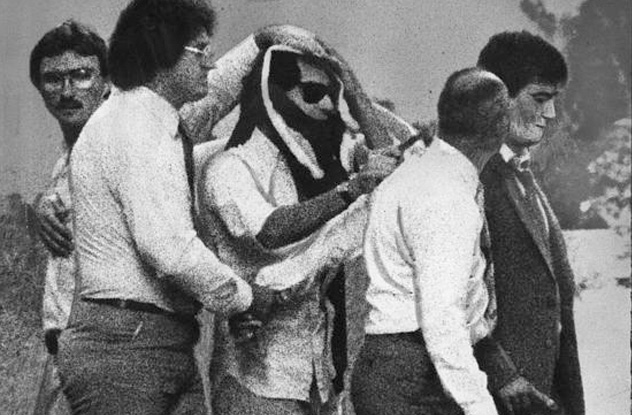
In 1984, Hakki Bahadir Atahan took a page out of the Al Pacino playbook and started his own little “Dog Day Afternoon” standoff with the cops. Atahan was a Turkish immigrant who’d moved to Australia in 1970, and for a while, life wasn’t so great. He’d tried starting his own bar, but the business soon collapsed. Atahan found himself divorced and driving cabs to pay the bills. Making things worse, he had a serious gambling problem.
Everything changed when Atahan traded in his taxi for a semiautomatic. Between March 1983 and January 1984, the man robbed 17 banks and became a criminal playboy.
He set up shop in a 16th-story apartment and lived like a king until one day in 1984 when he hit two banks in a row. By the time he got to bank three, the cops were on his tail. Surrounded, Atahan found himself trapped in the Commonwealth Bank in George Street, Sydney with a roomful of hostages.
Over the next two and a half hours, Atahan slowly released most of his 11 hostages. But when there were five male tellers left, the crook decided it was time to make his move. Atahan ordered the men to form a circle with him in the middle and then to put their hands on his head. The human wheel then made its way outside, past the cops, until Atahan hijacked a nearby car. With a hostage driving, Atahan drove for two hours before ending up on a drawbridge. It was his biggest and last mistake.
The authorities quickly raised the bridge, and Atahan suddenly didn’t have anywhere to hide. Panicked, the outlaw decided to go down guns a-blazin’. When the cops moved in, Atahan fired at Detective Constable Stephen Canellis, hitting the officer in the face.
Canellis survived, but we can’t say the same for Atahan. As soon as Canellis hit the ground, the rest of his buddies opened fire. Atahan should’ve stuck to driving cabs.
9The Blind Bank Robber

The robbers on this list are pretty diverse. We’ve got men and women, adults and teenagers. Some carried guns, while others relied on their brains. But everybody here shares one similarity . . . they could all see. Everybody except Robert Vernon Toye. He was legally blind and still managed to rob 17 banks.
Toye suffered from retinitis pigmentosa, a condition that caused his vision to slowly deteriorate. However, that didn’t stop him from becoming a blind Clyde Barrow. The man’s M.O. was pretty slick. He could see ever-so-slightly out of his right eye but not well enough to find a teller’s window. So Toye waited near the entrance for someone old and slow. When an elderly person shuffled on by (young people were too fast), Toye would lock onto their shoes and follow them to the counter.
Once he reached the window, Toye whipped out a playing card, a one-eyed Jack that read: “Be quick, be quiet, or you’re dead.” Even though he was almost always unarmed, Toye claimed he had a gun, and once the teller filled his bag, Toye pulled out his white cane and slowly made his way outside. The man was so smooth that a security guard once opened the door to let him out, never the wiser. Then Toye climbed into the taxi he had waiting and drove to the airport.
When Toye wasn’t robbing banks in New York City, he was living large in Las Vegas. And whenever the money ran thin, he’d board a plane, fly back to the Big Apple, and hold up another bank. But he didn’t always make a great escape. In 1977, the man walked right into a bunch of armed guards. He served some time, but once he got out in 1983, he made a quick $18,000 by putting a Coke bottle under his coat and claiming it was a gun.
Toye’s freedom didn’t last long, and he was soon serving 17 years in the big house. Most blind crooks would probably give up at this point, but not Toye. The man was an escape artist and tried to break out 11 times during his criminal career. Once, he even scaled two fences, using his cane to hold down the razor wire as he scrambled over the top. The jailbird was caught after he ran smack into a tree.
8The Choir Boy
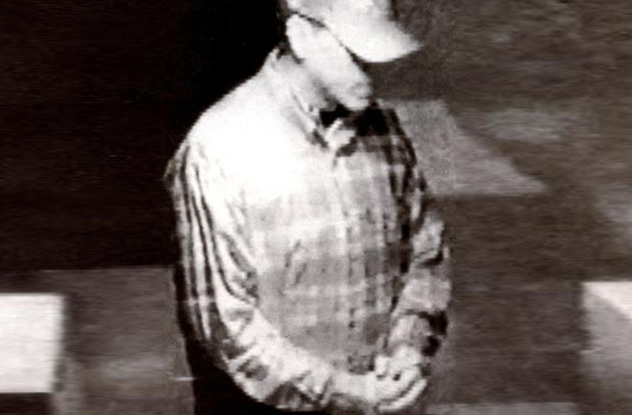
Tom Justice was a cycling aficionado who hoped to win gold in the Olympics someday, but that was just one goal in a long bucket list. He wanted to become an EMT, maybe sign up with the French Foreign Legion. And he wanted to rob a bank.
Justice didn’t just fantasize about stealing bags of cash. He made a detailed plan and rehearsed every day. After choosing a bank in Libertyville, Illinois, Justice picked a nearby spot to stash his bike and practiced walking from his hiding place to the front door, counting each step. At home, Justice rehearsed the trip in his mind by walking in place. He turned his bookshelf into a teller’s window and repeatedly practiced pulling the all-important note out of his pocket.
His first heist in 1998 was a success, largely due to his ingenious getaway. Once he returned to his safe spot, Justice stripped. Underneath, he was wearing compression shorts and a Spandex shirt. Next, he donned a messenger bag and pedaled down the road like he was delivering a package. But Justice didn’t keep his dough. He chucked some into a dumpster and left some in paper bags for homeless people—except for the $2 bills. He kept those as mementoes.
At first, robbing banks was just something to do, but after he injured himself training for Olympic trials, Justice abandoned his dreams of cycling glory and went hard-core. His illegal activities made him feel special, and between 1998 and 2002, Justice robbed 26 banks in three different states. Over time, authorities dubbed him the “Choir Boy Bandit.” Whenever he approached a teller, Justice bowed his head to avoid cameras and folded his hands to project an aura of calm.
Of course, you can only break the law for so long. In 2002, Justice hit a bank in Walnut Creek, California, but when a curious cop pulled him over, Justice took off on his bike. Eventually, the desperate crook ditched his bicycle and hid in a hole near the town’s eponymous creek. Unfortunately for Justice, the cops traced the bike, and a few months later, the Choir Boy was in handcuffs.
After serving nine years, Justice is finally free, but he’s far from content. He’s still looking for something as fulfilling as robbing banks.
7Robbery As PTSD Therapy
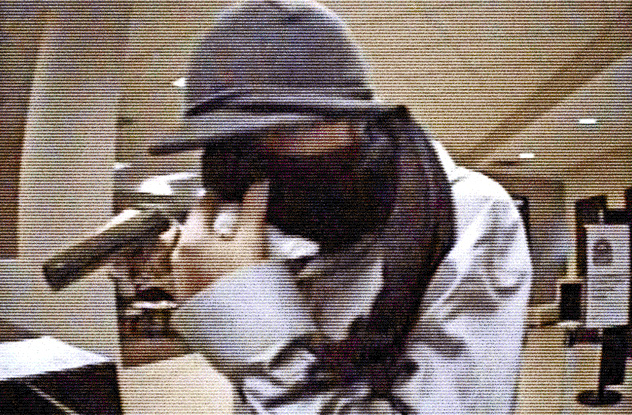
Nicholas Walker was an American hero. During 2005 and 2006, the man served as a medic in Iraq, and in 11 months, he went on about 250 combat missions, sometimes three a day. Walker won seven medals and commendations for valor, but he also saw some pretty horrible things. He witnessed the gory aftereffects of multiple IEDs, and on one mission, he watched as civilians were gunned down. He was never sure if they were insurgents or not.
When Walker returned home, he was suffering from a major case of post-traumatic stress disorder. He visited doctors, looking for help, but they all missed his PTSD. One psychiatrist even diagnosed him as bipolar. Thanks to their shoddy work, the man sank into a mental abyss. He stubbed cigarettes out on his arms, drove on the wrong side of the road, and violently punched himself. He divorced his wife and turned to heroin.
Walker’s world was a mess, and in December 2010, the man kind of snapped. He woke up one day and just decided he was going to rob a bank. As he put it, “I felt like I had been pushed into doing it. I was self-involved, bitter, and angry. I just didn’t want to take any
Over the next year, Walker kept his PTSD in check by robbing nine more banks. Whenever he passed the note to the teller, all his stress would just disappear. Once he’d escape, he’d give the money to friends or use it to score heroin. Sometimes he’d even burn the cash over his stove. But as the robberies escalated, so did his methods. He ditched the note for a gun and teamed up with lowlife thugs.
Walker’s crime spree finally came to an end in 2011. After taking over $7,000 from a bank in Lyndhurst, Ohio, Walker crashed his car and broke his back. Today, he’s spending 11 years in federal prison, but fortunately, once he was arrested, doctors finally diagnosed him with a “particularly severe and devastating case” of PTSD. So while he’s behind bars, at least he’s getting help to beat his awful disorder.
6The Catt Family Bank Robbers
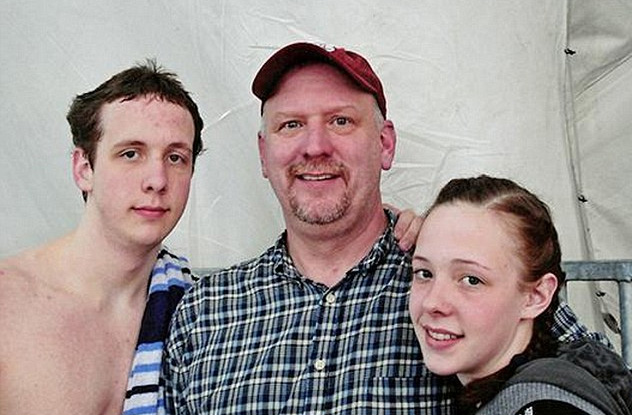
Scott Catt was an Oregon-born widower who struggled with that old demon alcohol and had trouble paying the bills. Forced to move in with his mother, Catt needed some quick cash, so he got an antique pistol and held up a local bank. Thus began an annual tradition. Every year when Catt needed to catch up on bills, he’d drop by a bank and steal a couple thousand dollars.
After robbing five banks, Catt packed his bags and moved to Texas. Soon, his 20-year-old son Hayden and 18-year-old daughter Abby followed their dad to the Lone Star State. It was about this time that Catt considered expanding his illegal operation. He wanted to start a gang, but it’s so hard to find good help these days, so he asked his kids to lend a helping hand. Hayden was easy to convince since he needed money for college. Abby was far more hesitant but caved in to pressure from her dad.
The Catt crew hit their first bank on August 9, 2012. Scott and Hayden, both tall and intimidating, wore painter’s masks and overalls. Abby dropped them off near a Comerica bank in Katy, Texas and parked behind the building. Then her brother and father marched inside carrying Airsoft guns. As they grabbed money inside the vault, Abby kept Scott up to date on how much time was going by.
The Catts scored nearly $70,000 on their first family outing. A few months later, they pulled a second job, only this time, they made a mistake. In preparation, Hayden and Abby scoped out the bank by pretending to be construction workers interested in opening accounts. They were caught on camera wearing orange safety vests. After they robbed the joint, detectives reviewing the security footage thought the vests were too clean to belong to construction workers. They tracked the vests to a local Home Depot, got Scott’s credit card info, and nabbed the family on November 9.
Instead of protesting their innocence, the Catts immediately confessed their guilt. Since Abby was pressured into acting as the getaway driver, she only got five years. Hayden was sentenced to 10 years in prison, which is light compared to Scott’s 24. Hayden and Abby hope to start new lives once they get out of jail, but as for Dad, he’ll be on the inside for a long time.
5America’s Oldest Bank Robber
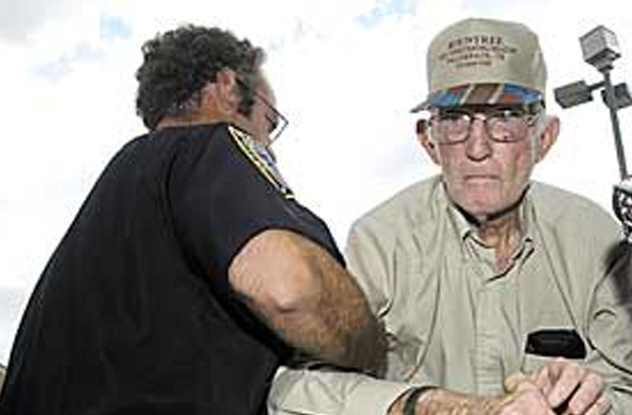
Think robbing banks is a young man’s game? Meet J.L. Hunter Rountree. Born in 1911, Rountree was a Houston businessman who made his living selling winches for oil rigs. He sold the business for millions, but his Cinderella story didn’t last long.
In 1965, he took a sizable loan to invest in a shipyard, but when the bank called his note before the agreed-upon time, Rountree went into bankruptcy. Things went downhill from there. His stepson died in 1986, and his wife of 50 years followed soon after. Despondent, the 83-year-old fell into booze and drugs before marrying and divorcing a 31-year-old. Frustrated with life, Rountree decided to shake things up a bit . . . by robbing banks.
Rountree was 86 when he hit the SouthTrust Bank in Biloxi, Mississippi. He ordered the teller to fork over the cash, but before he could escape, somebody followed him outside, and the game was over. The hoary holdup man got three years’ probation and a $260 fine, but he was back at it again a few months later.
This time, he got $8,000 from a bank in Pensacola, Florida, but an enthusiastic patron took him out with a karate kick. The grandpa earned three years behind bars, and when he was released in 2002, he headed back to Texas for one last heist. Sure, Rountree blamed banks for ruining his life, but it was more than just revenge. “You want to know why I rob banks?” he once asked a reporter. “It’s fun. I feel good, awful good.”
When he walked into the First American Bank in Abilene, Rountree was 91. After handing the teller a note reading “ROBBERY,” he tried to escape with his $1,999. Meanwhile, the bank’s vice president spotted his license plate number. Not long after, the old man was leading police on a high-speed car chase before finally pulling over. And when a cop approached his window, gun drawn, Rountree told the whippersnapper,“Take that damn thing out of my face.”
When Rountree went to trial, the elderly desperado earned 12 years for his final offense. He spent the last year of his life behind bars before dying at 92, going down in history as America’s oldest bank robber.
4The Inner Tube Bandit

Anthony Curcio was the king of his high school. The guy was captain of both the football and basketball teams, dated the cheerleading captain, and was going to college on a football scholarship. His future seemed bright, but a torn ACL put an end to his dreams and introduced him to the addictive world of Vicodin.
Soon, he was selling stolen furniture and counterfeit baseball cards to fund his drug habit. When he graduated from Vicodin to crack, he went into the real estate businesses, all the while spending $15,000 a month on drugs. When the housing market collapsed, a desperate Curcio dreamed up a bizarre plan to feed the monkey on his back. He was going to rob the local bank and do it with style.
On September 30, 2008, a group of men showed up on a stretch of blacktop near the Bank of America in Monroe, Washington. They were all responding to the same Craigslist ad, a lucrative job offer requiring applicants to show up at 11:00 AM wearing safety glasses, ventilator masks, yellow safety vests, and blue shirts. At 11:05, a Brinks truck pulled up to the bank, and one of the job hunters sprinted across the road. It was Curcio, armed with a can of mace.
After taking out the security guard, Curcio grabbed $400,000 and darted across the street, running past a bunch of men who looked just like him. So much for eyewitness descriptions.
Next, Curcio jumped into an inner tube he’d stashed by a nearby creek and floated downstream to a vehicle he’d parked a safe distance away. After months of planning, Curcio had gotten away clean . . . or so he thought.
He’d made one little mistake. A few weeks before the robbery, Curcio was going to rehearse the heist, but he panicked at the last minute and ditched his gear behind a dumpster. A homeless man spotted Curcio acting suspiciously, took down his license plate number, and called the cops. After the robbery, the cops put two and two together and matched Curcio’s DNA to the ventilator mask he’d foolishly left behind.
The inner tube bandit spent five years in federal prison, but he’s a free man today. Instead of doing crack, he writes children’s books teaching about the dangers of drug use and how crime doesn’t pay. He’s an expert on the topic.
3The Starlet Bandits

Henry McElvane wanted to be famous. That’s why he changed his name to Robert St. John and moved to Hollywood. Inspired by Richard Pryor and Eddie Murphy, St. John dreamed of becoming a great stand-up comic, but breaking into the comedy scene is hard work. To make ends meet, St. John pimped out teenage girls, one as young as 13. Sure, he got busted in 1997, but after an 11-year stint in prison, St. John went back to the business he knew best.
Things took a bizarre turn when one of his prostitutes, Danielle Derosier, tried robbing two banks in 2008. Both times, she wore a pair of sunglasses, put a phone to her ear, and asked the teller for cash. Both times, she failed miserably, but the FBI took notice and dubbed her the “Starlet Bandit” thanks to her shades.
Even though Derosier never stole one cent, she inspired another prostitute named Kadara Kilgo to follow in her high-heeled footsteps. In 2010, Kilgo convinced St. John that they should try again, and the two convinced a third prostitute, Mallory Mnichowski, to do the dirty work. Mnichowski was 19, pregnant, and not exceptionally bright . . . and she got away with nearly $6,000. With St. John as the getaway driver, the trio made a speedy escape and decided to embark on a new business.
Soon, the Starlet Bandits were hitting banks all across Southern California. Excited, other prostitutes begged St. John for a chance to rob a bank, and the all-girl gang got bigger and bigger. Each time, St. John waited in the car as one of the women walked inside the bank with her sunglasses and cell phone. The bandits weren’t supersmart (they sometimes hit the same banks within a few days), but they were really successful, getting away with thousands of dollars each time.
Things finally fell apart when the cops captured a bandit named Kayla Canty who quickly spilled the beans. Thanks to her confession, the authorities tracked down St. John and were able to definitively prove he was the mastermind. How? St. John was still on parole and had to wear an ankle bracelet, which put him at the scene of every single robbery. In 2011, the pimp was sentenced to eight years, putting an end to the Starlet Bandits—and his dreams of stand-up comedy.
2The Whiskey Robber
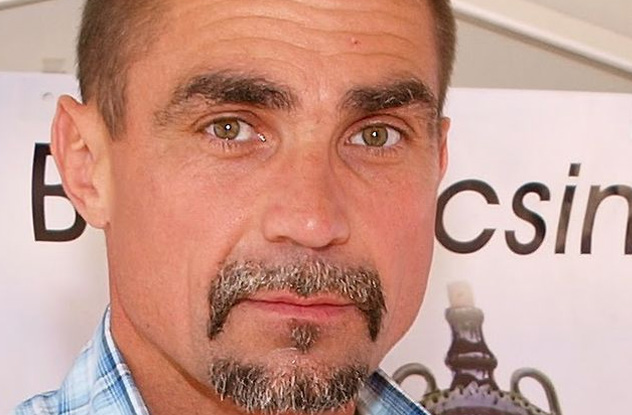
In 1988, Attila Ambrus escaped communist-controlled Romania by hanging on the underside of a freight train. Once he showed up in Hungary, he tried out as a goalie for the UTE hockey club and did such a bad job that the coaches felt sorry for him and gave him a spot on the team.
Ambrus was a horrible goalkeeper and once gave up 23 goals in a single game. But when he wasn’t screwing up on the ice, he was driving a Zamboni around the rink, cleaning up the stadium, and sleeping in his locker room because he had nowhere else to stay. He also made extra cash digging graves, smuggling items across the border, and robbing.
After ending up in some serious debt, Ambrus got a wig and a toy gun and held up a local post office. The robbery went so well that he decided to give up selling pens and walking dogs and go professional criminal. So when he wasn’t playing hockey (he never missed a day’s practice), Ambrus was studying banks, post offices, and travel agencies, trying to find easy marks.
Ambrus never hurt anyone during his robberies, and he had a rather flamboyant style. Before he struck, he always stopped by a nearby bar to down a glass of Johnnie Walker whiskey, earning him the title of “The Whiskey Robber.” Whenever he waltzed into a bank, he handed roses to female tellers, and like any good supervillain, he appreciated his enemies. He even went so far as to send a bottle of wine to the police chief chasing him down. As you might expect, he became something of a folk hero.
Ambrus hit over 20 different locations—once even dressed as a cop—before authorities tracked him down. He didn’t stay behind bars for long. In July 1999, he tossed his bed sheets out a four-story window and rappelled down the side of the jail. During his short stay on the outside, he committed three more robberies, bringing the total to 29 before he was caught trying to cross the border.
After 12 years in prison, the charming crook was finally released. Today, he’s probably relaxing somewhere, enjoying his Johnnie Walker whiskey.
1France’s Greatest Gangster
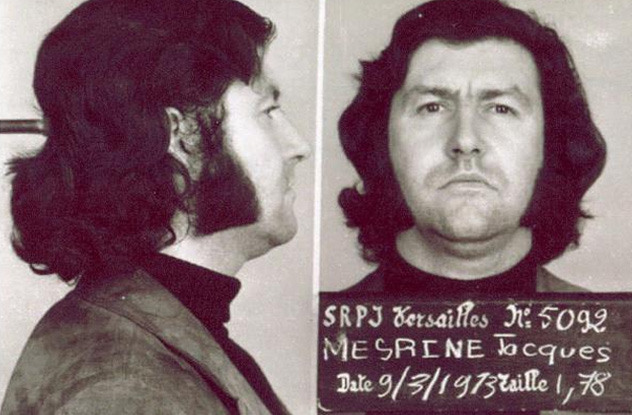
In the US, there’s Jesse James and John Dillinger. In France, there’s Jacques Mesrine. During his crime spree, Mesrine robbed countless banks, broke out of four prisons, and was declared “Public Enemy Number One” in France and Canada. And he did it all while dating models and appearing in magazines.
After serving in a torture squad during the Algerian War, Mesrine returned to Paris a hardened criminal. The man hit bank after bank before stealing some money from the wrong people. The gangster was forced to hide in Quebec, where he spent his free time holding a billionaire for ransom.
Mesrine wound up in a max-security Canadian prison, but the crook cut his way out, armed with only a pair of pliers. Then he returned with a friend and some sawed-off shotguns. Mesrine wanted to free the 56 other prisoners in his wing, and though the rescue attempt failed, let’s give the man points for trying.
After withdrawing cash from several Canadian banks, he went back to France and declared war on the country’s bankers. Sometimes, he robbed two banks a day, just minutes from each other. When he heard sirens coming, he’d leave one and head for the other. The man just loved it when the cops showed up at the wrong bank.
Mesrine was a master of disguise with a collection of wigs and glasses and sometimes even shaved his head. He never left home without a plan. When he was arrested again in 1973, Mesrine faked a bout of diarrhea, retrieved a gun his friend had planted in a courthouse toilet, and escaped by taking a judge hostage.
The man was also a publicity hound. After escaping prison in 1978, he enjoyed giving interviews to major magazines and posing for photos with his machine guns. Mesrine was a superstar, consistently voted the most popular man in France.
However, his popularity faded when he tortured a journalist for running a negative story about him. Soon, he tried to kidnap a judge who’d sentenced him to prison, and after he captured another rich businessman, the president of France made it clear the gangster had to go.
On November 2, 1979, Mesrine was driving along when he stopped behind a covered truck. Suddenly, the tarp was yanked back, and there was a small army of cops with automatic weapons. The gangster went out like Bonnie and Clyde, which is probably how he wanted to go—in style.
If you want, you can friend/follow Nolan on Facebook, or you can send him an email.








